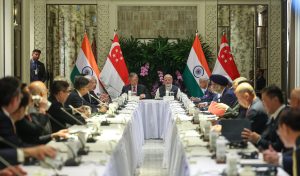Prime Minister Narendra Modi’s visit to Singapore and Brunei Darussalam in early September once again underscored Southeast Asia’s enormous significance in Indian foreign policy – not only for strategic and economic reasons but because India cannot credibly claim to be a global power until it demonstrates that it can play a meaningful role within its own extended neighborhood. The Indian government has pursued the Look/Act East policy for three decades with the aim of strengthening its security, trade, and cultural presence within the ASEAN region. “For India, no region now receives as much attention as this,” Modi declared at the Shangri La Dialogue in 2018.
Yet, after 30 years of the Look/Act East policy, the relationship has failed to gain momentum on its own, and India is struggling to define a meaningful role for itself in Southeast Asia. For the last six years, the ISEAS-Yusof Ishak Institute’s The State of Southeast Asia surveys have found that the region’s elites consistently rank India lowest among all major powers in terms of its strategic, political, or economic influence in Southeast Asia. In 2024, nearly 2,000 respondents from academia, governments, and civil society across the region ranked India ninth out of 11 major powers in its strategic relevance to the ASEAN countries.
A key cause of India’s inability to carve out a greater role for itself in the region is the fundamental divergence in their international approaches. Although Southeast Asian countries are not a monolith, they have developed a broad consensus on four key questions. India maintains a markedly different outlook on all four.
First, as small countries facing significant external threats, Southeast Asians support and wish to strengthen the existing U.S.-led rule-based global order, some misgivings aside. The ISEAS-Yusuf Ishak survey shows that the regional elites continue to favor U.S. leadership of the world. India, on the other hand, espouses a multipolar world. Despite its improving relations with the United States, it has often expressed skepticism toward U.S. global leadership. The ongoing Ukraine War provides a clear instance of the stark divide between India and Southeast Asian countries. While most of the region has supported United Nations resolutions condemning the Russian invasion, India had consistently abstained from voting against Moscow’s interests.
Second, Southeast Asian countries have pursued a relatively firm but friendly approach toward China. While wary of Beijing’s rising assertiveness, they have sought mutually beneficial economic cooperation and tried to avoid sustained confrontation with it. They have been careful not to be swept up in the emerging China-U.S. rivalry. Meanwhile, India’s relations with China have sharply deteriorated following their border skirmish in 2020. New Delhi considers Beijing to be its strategic and economic rival, and it increasingly sees its presence in Southeast Asia as a direct competitor to China. This zero-sum mindset has made many in the region uncomfortable.
Third, export-dependent Southeast Asian countries broadly support liberal international trade, while India is often ambivalent and hesitant to open up its markets. While calling for an “open” Indo-Pacific, the Modi government has also promoted protectionist policies under its “Make in India” campaign. As per the latest data from the World Trade Organization, the average import tax in India is 18.3 percent, while in Southeast Asia it ranges from 0 to 11.5 percent. In 2019, India backed out of the ASEAN-centered free trade agreement called the Regional Comprehensive Economic Partnership (RCEP) at the last minute. India’s trade deficit with Southeast Asia has grown rapidly in the last two decades to reach nearly a quarter of the total trade, which makes it all the more hesitant to keep its market open to the manufacturing hubs of the region.
The final point of difference is regional multilateralism, a highly-prized feature of Southeast Asian politics. ASEAN is one of the most successful regional organizations in the world, instrumental in fostering peace and economic cooperation in the region. In contrast, India is a reluctant regionalist. Historically, New Delhi has preferred to deal with its smaller South Asian neighbors bilaterally rather than multilaterally. South Asia is one of the least integrated regions in the world, with moribund regional forums. While New Delhi has sought to act as a constructive partner to ASEAN, it has yet to demonstrate that it can champion regional cooperation and lead the establishment and management of regional institutions.
The divergence between the international outlooks of India and Southeast Asia places limits on what the Look/Act East policy can achieve. India’s incremental investments in the region through trade deals or military exercises are unlikely to bridge the divide. In fact, as the international order comes under growing strain, differences over such first-order principles will become increasingly salient. To establish itself as a significant actor in the region, India needs to consciously seek common ground with Southeast Asian countries on fundamental questions of regional order. Rather than assuming that others will follow its lead by default, it has to invest in understanding the needs and perspectives of its neighbors in order to encourage a united front to confront future challenges.
To lead Asia, India may need to rethink some of the basic precepts of its worldview.

































